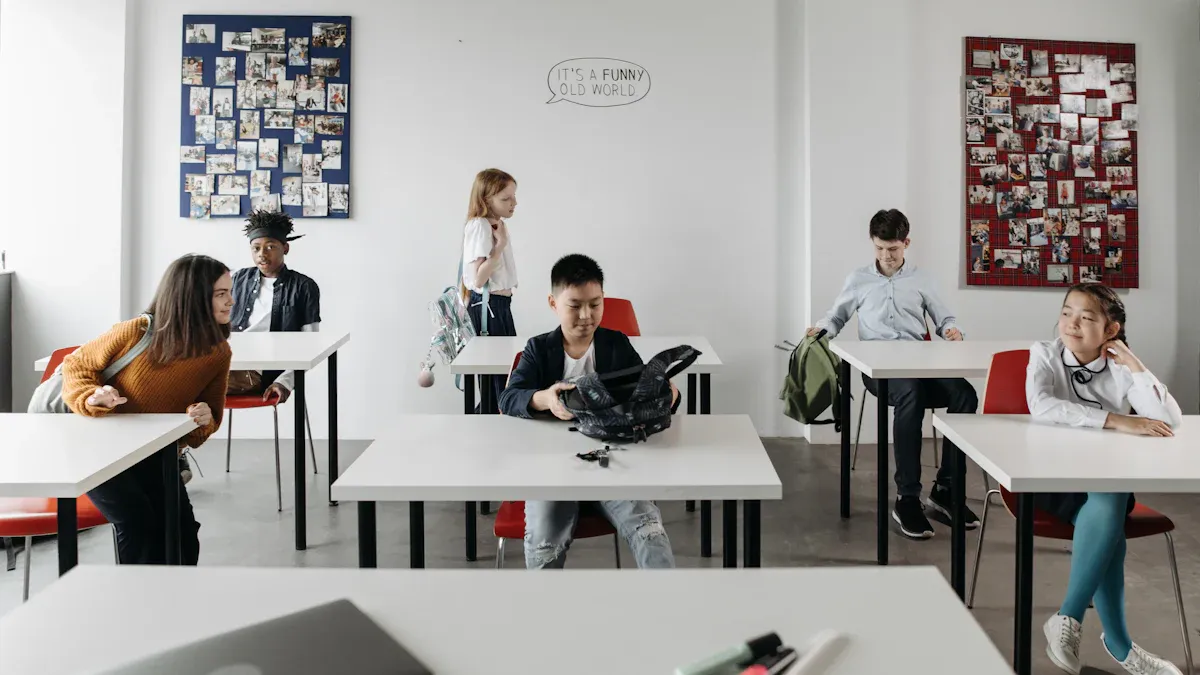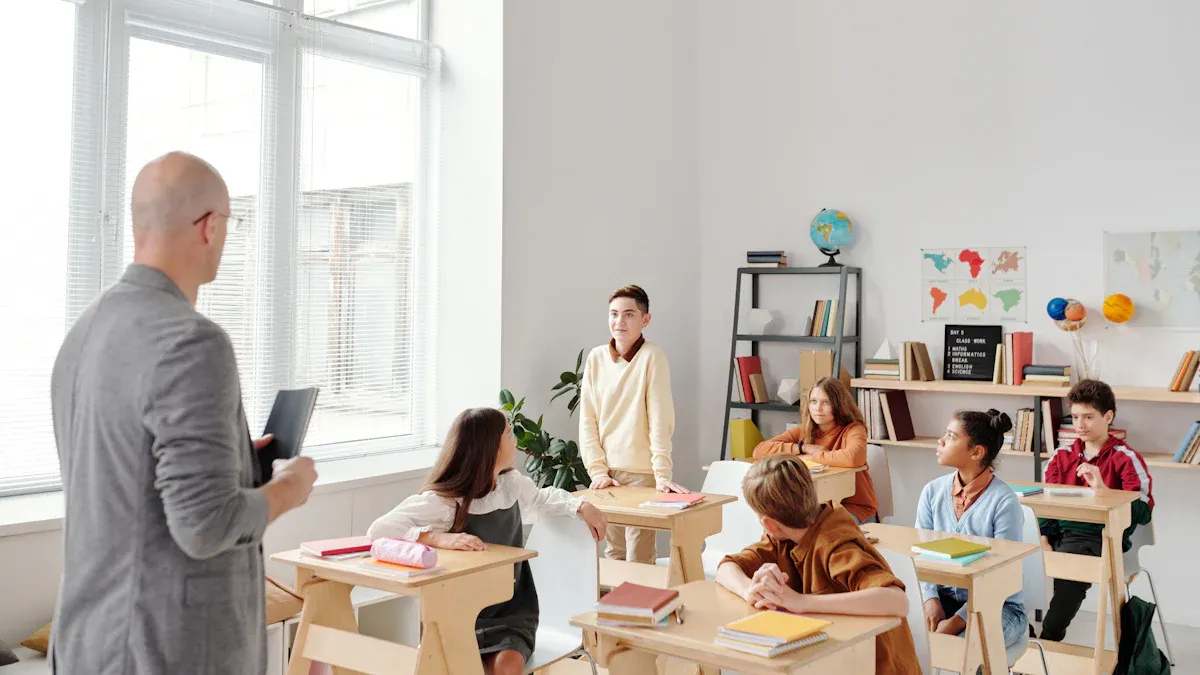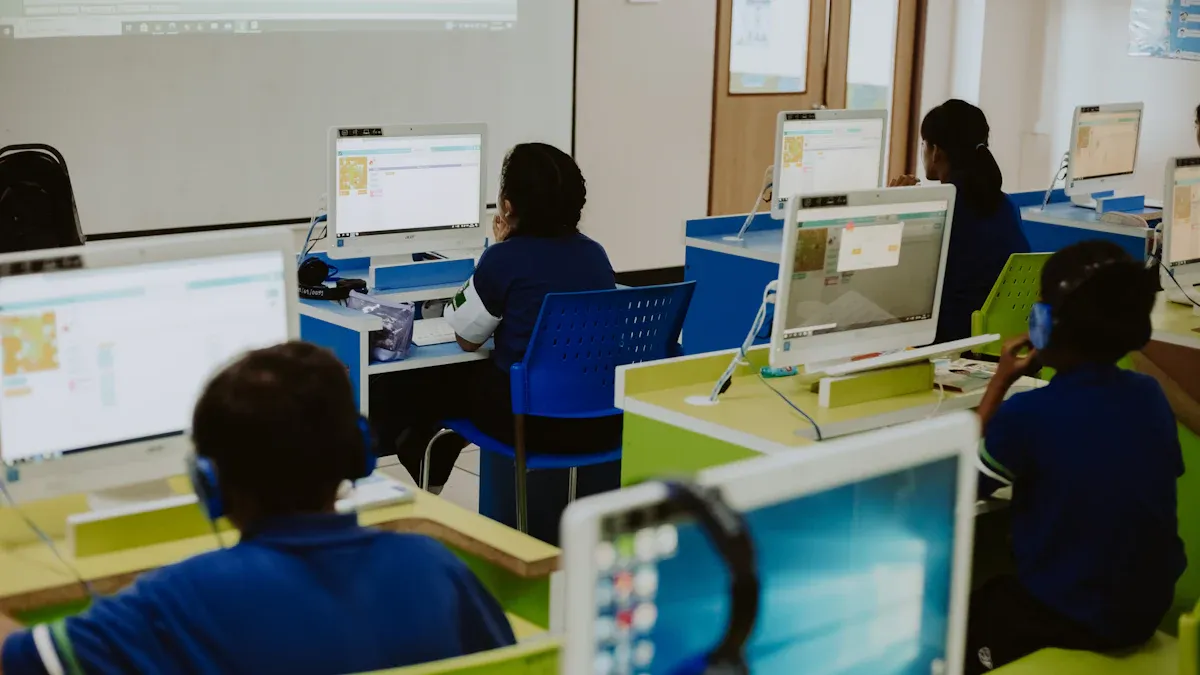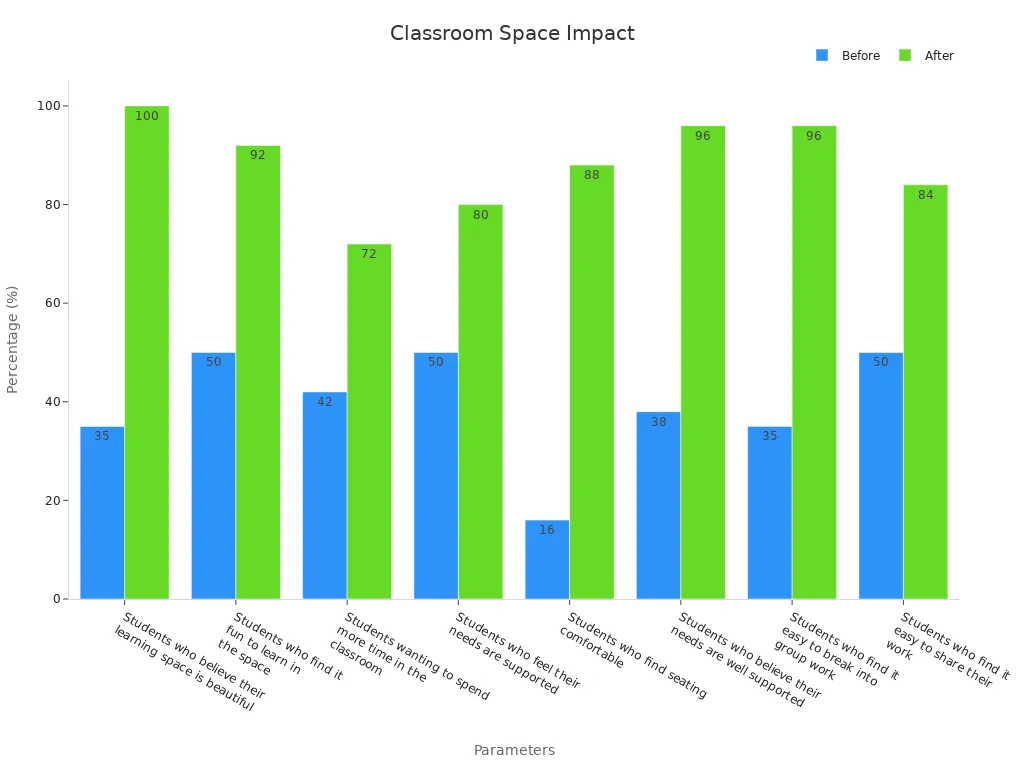
A smart classroom design layout transforms traditional learning spaces into dynamic environments that foster creativity and collaboration. It integrates technology, flexible furniture, and thoughtful organization to meet the needs of both students and teachers. This approach enhances the learning experience by making it more interactive and engaging.
The importance of a well-planned layout cannot be overstated. A thoughtfully designed space improves focus, supports diverse learning styles, and encourages teamwork. For example, 96% of students find it easier to work in groups, and 84% feel more comfortable sharing their work with others in such environments. Additionally, 92% of students report that learning becomes more enjoyable, while 72% express a desire to spend more time in the classroom.
By prioritizing comfort, accessibility, and adaptability, a smart classroom design layout creates a space where students thrive academically and socially.
Learn what students and teachers need for a helpful classroom.
Match the classroom setup with learning goals to boost teamwork.
Use movable furniture and tech to fit future learning styles.
Ask students and teachers for ideas to improve the classroom.
Make separate areas for activities to help focus and teamwork.
To create an effective smart classroom design layout, you must first understand the unique needs of both students and teachers. Students benefit from spaces that encourage movement, collaboration, and focus. For example, research from the University of Salford shows that classroom design features can impact academic progress by up to 25% in a single school year. Teachers, on the other hand, need layouts that allow them to move freely, provide individual attention, and access technology seamlessly.
Incorporating movement into learning improves cognition, memory, and recall. Similarly, when teachers can move around the classroom, they engage students more effectively.
By addressing these needs, you can create a space that supports both teaching and learning.
Your classroom layout should reflect your educational goals. Flexible designs accommodate various teaching methods, from lectures to group activities. For instance, roundtable seating arrangements promote active learning and collaboration, while fixed seating often limits engagement. A well-thought-out layout balances individual and group workspaces, catering to diverse learning styles.
Flexible designs enhance student-centered learning.
Mobile arrangements empower students to learn on their own terms.
Classrooms aligned with objectives foster collaboration and independent thinking.
When your layout aligns with your goals, it creates an environment where students thrive academically and socially.
Technology evolves rapidly, so your smart classroom design layout must adapt to future needs. Flexible spaces make it easier to integrate new tools like AI-driven learning systems or interactive displays. Data-driven insights can also guide your design choices. For example, student engagement data can help you arrange seating to maximize participation.
Aspect | Description |
|---|---|
Student Engagement Data | Insights on student engagement can inform better classroom layouts that enhance participation. |
Differentiated Instruction | Data helps in grouping students based on proficiency, influencing classroom arrangement. |
Scaffolding Effectiveness | Data-driven practices ensure students receive necessary support, impacting classroom design choices. |
By planning for advancements, you ensure your classroom remains relevant and effective for years to come.
Start by measuring the dimensions of your classroom. Knowing the size and shape of the space helps you plan an efficient layout. Pay attention to the location of windows, doors, and electrical outlets. These features influence how you arrange furniture and technology. For example, placing interactive displays near power sources reduces the need for long cables. Consider creating zones for different activities, such as group discussions, individual work, and presentations. This approach enhances functionality and supports diverse learning styles.
Tip: Use a simple sketch or digital tool to map out your classroom. Include all key features like outlets and natural light sources.
Before making changes, assess what you already have. Conduct an audit of your classroom to analyze the current layout, furniture condition, and available technology. Check the wiring infrastructure to ensure it can support new devices. Gather feedback from teachers about what works well and what doesn’t during lessons. This step helps you identify areas that need improvement. For instance, outdated projectors or insufficient seating might hinder the effectiveness of your smart classroom design layout. Use this evaluation to prioritize upgrades that align with your goals.
Budgeting is crucial for a successful transformation. Group your costs into categories like hardware, software, installation, furniture, and training. Research current prices from reliable vendors to estimate expenses. Justify each cost by linking it to your educational objectives. For example, investing in ergonomic furniture can improve student comfort and focus. Present your budget as both a one-time expense and a multi-year plan. This approach ensures you allocate resources effectively while planning for future needs.
Note: A well-planned budget not only saves money but also ensures your classroom meets its full potential.
Organizing your classroom into distinct zones for individual and group activities enhances functionality and engagement. A flexible layout allows students to focus on quiet, independent tasks while also encouraging collaboration in group settings. For example, creating a reading corner with comfortable seating can provide a calm space for individual work. Meanwhile, arranging tables in clusters fosters teamwork and discussion.
Define areas for specific activities like reading, writing, and technology use.
Use visual cues, such as rugs or partitions, to guide students and differentiate spaces.
Balance the layout to cater to diverse learning styles and needs.
This approach not only supports various teaching methods but also prepares students for real-world environments where adaptability is key.
A dedicated space for presentations and lectures ensures that students can focus and engage effectively. Position interactive displays or projectors in a central location where everyone has a clear view. Arrange seating to maximize visibility and minimize distractions. For example, a semi-circular seating arrangement can help students feel more connected to the presenter.
Tip: Use mobile furniture to quickly transform the lecture area into a collaborative space when needed.
By thoughtfully designing this zone, you create an environment that supports both teacher-led instruction and student presentations.
Accessibility and movement play a crucial role in the success of your smart classroom design layout. Arrange furniture to allow students and teachers to move freely without obstacles. Flexible seating options, such as chairs on wheels, make it easier to reconfigure the space for different activities.
Ensure pathways are wide enough for all students, including those with mobility challenges.
Avoid rigid layouts that hinder interaction and collaboration.
Use lightweight furniture to simplify rearrangement.
Studies show that well-designed classrooms can improve academic progress by up to 25% in a single school year. A layout that prioritizes accessibility fosters collaboration and enhances learning outcomes.

Choosing the right furniture is essential for creating a smart classroom design layout that supports learning. Flexible and ergonomic furniture allows students to adjust their seating to suit their needs, promoting comfort and focus. For example, ergonomic chairs encourage proper posture, reducing discomfort and preventing musculoskeletal issues. This not only improves concentration but also fosters a more inclusive learning environment where all students feel supported.
Incorporating a variety of seating options, such as stools, high-top tables, or lounge chairs, can make the classroom more dynamic. Students often enjoy having choices, and 96% of them report feeling better supported when different seating and table options are available. Additionally, involving students in the furniture selection process ensures the space meets their needs, making it more enjoyable and engaging.
The placement of interactive displays and projectors significantly impacts how effectively students engage with lessons. Position these tools where every student has a clear view, such as at the center of the classroom or along a prominent wall. Avoid placing displays near windows to reduce glare, which can hinder visibility. A semi-circular seating arrangement can further enhance visibility and interaction during presentations.
Mobile stands for displays or projectors can add flexibility, allowing you to reconfigure the classroom for different activities. This adaptability ensures that technology remains accessible and functional, regardless of the lesson format.
Proper cable management is crucial for maintaining a safe and organized classroom. Use cable organizers or floor covers to prevent tripping hazards and keep wires out of sight. Position power outlets strategically to minimize the need for long cables. For example, placing outlets near workstations or interactive displays reduces clutter and ensures seamless connectivity.
Reliable internet access is equally important. Ensure that all devices, including tablets and laptops, can connect to the network without interruptions. A well-connected classroom enhances collaboration and supports the integration of digital tools, making learning more interactive and efficient.

Smartboards and digital displays transform traditional teaching methods into interactive experiences. These tools allow students to engage directly with the content, whether by solving problems on the board or participating in group activities. For example, smartboards enable multiple students to interact simultaneously, fostering hands-on learning. Teachers often report increased engagement when using these tools, as students become more attentive and involved in lessons.
Benefit | Description |
|---|---|
Interactivity | Smartboards allow multiple students to engage simultaneously, enhancing hands-on learning. |
Increased Engagement | Teachers report a significant rise in student engagement when using smartboards in classrooms. |
Improved Learning Outcomes | The use of smart technology correlates with higher test scores and better comprehension. |
By incorporating smartboards and digital displays into your smart classroom design layout, you create an environment that supports diverse learning styles and improves overall academic performance.
Providing devices like tablets and laptops ensures students have access to modern learning tools. These devices enhance engagement and collaboration by enabling students to work on interactive assignments and share ideas in real time. For instance, touchscreen devices have been shown to improve mathematics achievement compared to traditional methods. Additionally, interactive eBooks on tablets aid comprehension more effectively than print books.
Digital devices foster active participation in lessons.
70% of college students find laptops helpful for note-taking and academic performance.
Touchscreen devices significantly improve learning outcomes in subjects like math.
Equipping your classroom with these devices not only supports differentiated instruction but also prepares students for a technology-driven world.
Collaborative software and apps streamline group work and enhance communication among students. Tools like task management apps, discussion forums, and collaborative document editors encourage active participation. For example, centralized platforms for messaging and file sharing improve project organization. Students can also provide peer feedback through anonymous surveys, fostering a supportive learning environment.
Discussion forums promote active participation.
Task management tools improve organization and scheduling.
Collaborative document editing encourages teamwork and creativity.
By integrating these tools, you create a classroom where students can work together effectively while developing essential 21st-century skills.
Enhancing the visual and acoustic elements of your classroom can significantly improve student focus and engagement. Bright, vibrant colors on walls or furniture create a welcoming atmosphere. Adding artwork or motivational posters can inspire creativity and positivity. Acoustic panels or rugs help reduce noise, ensuring a quieter environment conducive to learning.
Studies show that well-designed classrooms can impact academic progress by up to 25% in a single school year. Features like room orientation, acoustics, and furniture play a crucial role in creating an effective learning space.
Furniture like the Ruckus chair supports neurodiverse learners by accommodating different learning styles. Students feel more comfortable and engaged when their environment meets their sensory needs.
Lighting plays a vital role in creating a versatile learning environment. Adjustable lighting systems allow you to tailor the brightness and color temperature to suit various activities. Cooler light increases alertness during morning lessons, while warmer light creates a relaxed atmosphere for reading or discussions. Brighter light works best for hands-on tasks requiring focus, and dimmer light fosters a calm setting for group work.
Lighting Type | Effect on Activity |
|---|---|
Cooler Light | Increases alertness for morning classes |
Warmer Light | Suitable for relaxation and quiet activities |
Brighter Light | Useful for hands-on tasks requiring focus |
Dimmer Light | Creates a relaxed atmosphere for discussions |
Flexible lighting systems enhance student engagement by adapting to their needs, making the classroom more dynamic and inclusive.
Effective storage solutions keep your classroom organized and efficient. Shelves, bins, and lockers ensure materials are easily accessible, saving time during lessons. Organized spaces also promote mobility, allowing students and teachers to transition smoothly between activities.
Tidy environments improve focus and reduce distractions.
Accessible storage helps students develop organizational skills.
Teachers save instructional time by locating resources quickly.
By incorporating storage into your smart classroom design layout, you create a space that supports both learning and teaching.

Feedback from students and teachers is essential for refining your smart classroom design layout. Their insights help identify what works and what needs improvement. Use surveys, focus groups, or informal discussions to gather their opinions. For example, students might suggest changes to seating arrangements that improve collaboration, while teachers could highlight areas where technology integration feels seamless or challenging.
Data can reveal the status of a learning environment and shape it effectively. By continuously analyzing student data, educators can make informed adjustments to optimize learning and classroom design.
To make feedback actionable, follow these steps:
Use data to guide instructional changes that meet student needs.
Set measurable goals based on feedback to monitor progress.
Continuously assess the impact of changes to ensure they align with educational objectives.
This process ensures your classroom evolves to meet the needs of its users effectively.
Practical use often reveals challenges that were not apparent during the planning phase. Observe how students and teachers interact with the space daily. For instance, if students struggle to see the interactive display from certain angles, repositioning it might improve visibility. Similarly, if group activities feel cramped, rearranging furniture could create more space.
Teachers have long recognized the importance of adapting their methods to meet diverse student needs. Data-driven strategies enhance this process by providing clear insights into student progress. Adjustments based on feedback, such as incorporating more interactive activities, can boost participation and address specific learning needs.
Data-driven adjustments lead to actionable changes in teaching strategies.
Regular evaluations help identify effective practices and areas needing improvement.
Targeted changes optimize learning for both individuals and the entire class.
By making thoughtful adjustments, you create a more functional and engaging learning environment.
Educational needs and technology evolve rapidly. Regular updates to your classroom layout ensure it remains relevant and effective. Flexible designs, such as movable furniture, allow you to adapt the space for various activities and class sizes. A balanced layout that supports both individual and group work prepares students for diverse future work environments.
Flexible classroom designs accommodate diverse learning styles.
Movable furniture supports easy rearrangement for different activities.
Regular updates ensure the space aligns with modern educational goals.
By staying proactive, you ensure your smart classroom design layout continues to foster engagement and collaboration.
Creating a smart classroom design layout involves thoughtful planning and continuous refinement. Start by defining your goals, assessing your space, and organizing zones for various activities. Choose flexible furniture and integrate interactive tools to support diverse learning needs. Personalize the space to enhance comfort and engagement.
Adaptability ensures your classroom evolves with changing educational needs. Flexible layouts improve student participation, while movable furniture supports different teaching methods. Collaborative spaces also foster peer learning, making your classroom dynamic and inclusive.
Take the first step today. Begin designing a space where students thrive academically and socially.
Start by defining your goals. Identify the needs of students and teachers, and align the layout with educational objectives. This ensures the space supports learning and teaching effectively.
Use flexible furniture and modular designs. Plan for additional power outlets and internet connectivity. This allows you to integrate new tools like AI systems or interactive displays without major changes.
Incorporate smartboards, tablets, and collaborative software. These tools encourage teamwork and active participation, helping students develop essential skills for modern education.
Arrange furniture to allow free movement. Use lightweight, mobile seating options. Ensure pathways are wide enough for students with mobility challenges. Accessibility fosters inclusivity and enhances learning outcomes.
Install adjustable lighting systems. Bright light boosts focus during tasks, while dimmer settings create a relaxed atmosphere for discussions. Tailoring lighting to activities enhances comfort and productivity.